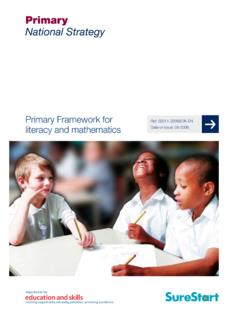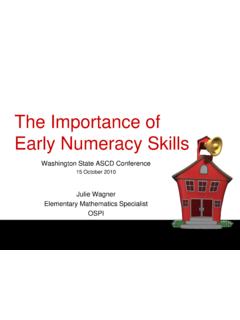Transcription of Multiplication & Division - The Mathematics Shed
1 - 4- 4012345678 Multiplication & Division 1 2 3 4 5 6 7 8 9101112131415161718192021222324252627282 9303132333435363738394041424344454647484 9505152535455565758596061626364656667686 9707172737475767778798081828384858687888 990919293949596979899100 3 sets of 2 = 63 lots of 2 = 63(2) 6 3 44 3 2001 Andrew HarrisMultiplication & Division1 2001 Andrew HarrisContentsSymbolic Encoding and Abstraction in Multiplication and Division3 Conceptual Structures for Multiplication4 Conceptual Structures for Division6 The Relationship between Multiplication and Division7 progression in Teaching Multiplication and Division8 General Summary of Progression8 Prior Experience Required for Learning about Multiplication & Division8 progression in Multiplication8 progression in Division9 Establishing Initial Understanding of Multiplication9 From Unitary Counting to Counting Multiples9 Introducing Repeated Addition10 Introducing the Symbol14 Establishing Initial Understanding of Division15 Fairness and Equal Sharing15 Introducing Repeated Subtraction17 Introducing the Symbol18 Learning Basic
2 Multiplication and Division Facts20 Teaching Strategies for Doubling and Halving21 Strategies for Teaching Multiplication Facts up to 10 1022 Links between Multiplication and Division Facts30 Factors and Multiples30 Divisibility Rules31 Teaching Mental Calculation Strategies for Multiplication and Division33 Characteristics of Mental Multiplication and Division Strategies34 Common Mental Strategies for Multiplication and Division35 Using Recording to assist Mental Calculation37 Remainders and Rounding when Dividing38 Developing Written Algorithms (Methods) for Multiplication and Division39 progression in Written Methods for Multiplication40 progression in Written Methods for Division44 Errors and Misconceptions in Multiplication and Division Calculations48 Common Errors and Misconceptions in Multiplication50 Common Division Errors and Misconceptions51 Square, Prime and Rectangular Numbers53 Glossary of Mathematical Terms associated with Multiplication and Division55 Multiplication & Division2 2001 Andrew HarrisSymbolic Encoding and Abstraction in Multiplication and DivisionIt is important for any teacher to realise that an apparently simple mathematical statement suchas 3 2 = 6 has a multiplicity of meanings.
3 For a start, the number 3 in the statement couldmean many things, for example, 3 objects (toy cars or multilink cubes or shells etc.), 3 groupsof objects, a position on a number line or simply an abstract number. The same is true of thenumbers 2 and 6 in this statement. Thus, the numbers in the statement are generalisations ofmany different types of 3s, 2s and 6s found in different contexts. In addition, the complete statement 3 2 = 6 itself is a generalisation which can represent manydifferent John earns 3 each day for 2 days and so earns 6 in total;A rectangle with dimensions 3cm and 2cm has an area of 6cm2;A piece of elastic 3cm long is stretched until it has doubled in length to become 6cm long. Thus, to young children the statement 3 2 = 6 often has little meaning when no context isgiven. A similar argument applies to simple Division statements.
4 Consequently, all earlymultiplication and Division work should be done by means of practical tasks involving childrenthemselves, real objects or mathematical apparatus in which the context is entirely , recording of Multiplication and Division work should also, for the most part, containsome representation of the operations attempted. This can be in the form of the objectsthemselves or in pictorial , the Multiplication symbol, , and the Division symbol, , also both have amultiplicity of meanings. This can be seen in the conceptual structures for Multiplication anddivision which follow. The manipulative actions undertaken by a child using real ormathematical objects, and which are represented by the 3 2 = 6 Multiplication statement, varyaccording to context of the task. The outcomes of these potentially different physical processesresulting from multiplying 3 2 in different contexts can all be represented by the number 6and so mathematicians can use the statement 3 2 = 6 to represent many different types ofmultiplication.
5 This efficiency and economy of expression is one of the attractions ofmathematics. However, for young children, the representation of very different physicalmanipulations of objects by the same set of mathematical symbols (3 2 = 6) is often confusingbecause of the high degree of generalisation and abstraction involved. Therefore, mathematicalsymbols at this early stage should only be used alongside other forms of representation such aspictures or actual objects. A similar complexity applies to Division which also has a multiplicityof meanings which are dependent upon different conceptual structures of Multiplication and Division that children will encounterare explained on the following pages. Note that the model of Multiplication or Division adoptedfor a calculation depends on the context and phrasing of the question & Division3 2001 Andrew HarrisConceptual Structures for Multiplication1.
6 Repeated AdditionThis is the first Multiplication structure to which children should be introduced. It buildsupon the already established understanding children have about addition but extends thisfrom adding the contents of a grouping to adding the contents of one group and then usingthis to add the contents of several equally-sized groups. For understanding thismultiplication structure, prior experience of equal groupings and of addition is examples of this type of Multiplication are:With Objects3 + 3 + 3 + 3 = 3 4(3 multiplied 4 times)On a Number Line01234567+2+2+22 + 2 + 2 = 2 3 = 6Or with Number Rods ( Cuisenaire)012345672 + 2 + 2 = 2 3 = 62222. Describing a Rectangular ArrayThis is likely to be the second Multiplication structure to which children are introducedformally. It becomes useful when the commutative law for Multiplication ( a b = b a)is encountered since this provides a visual representation of this law.
7 It is also encounteredMultiplication & Division4 2001 Andrew Harriswhen the formula for the area of a rectangle (Area = length breadth) is possible examples of this are:8 33 85 22 53 44 33. ScalingThis is probably the hardest Multiplication structure since it cannot be understood bycounting though it is frequently used in everyday life in the context of comparing quantitiesor measurements and in calculations of the cost of multiple purchases, for examples of this are:4cmAfactor of a scale2cmCB8cmfactor of 2 Multiplyingby a scaleB is twice the height of is times as highas that the result of such a scaling operation may result in a reduction in the quantity ormeasurement if the scale factor is less than Multiplication structure also includes the idea of rate . For example: the cost of 5 bars of chocolate @ 30p each is calculated as 30p 5 = ; if each tin of paint will cover 7m2 of wall space, the amount of wall space whichcan be covered using 10 tins of paint is calculated as 7m2 10 = & Division5 2001 Andrew HarrisConceptual Structures for Division1.
8 Equal Sharing8 4 is interpreted as Share 8 equally between 4 groups howmany in each group?The image here is of partitioning the set of 8 into 4 (equal) new is important that children are made aware that it is not always appropriate nor is it alwayspossible to interpret Division as equal sharing. For example, 8 0 2 or 8 both becomenonsense if interpreted as equal sharing because the number of groups into which items areshared would not be a whole number. Thus, in equal sharing situations,the divisor mustbe a whole number and less than the dividend and, consequently, the quotient will besmaller than the Repeated Subtraction (or Equal Grouping)This involves repeatedly subtracting the divisor from the dividend until either there isnothing left or the remainder is too small an amount from which to subtract the divisoragain.
9 It should be obvious that prior experience of subtraction is a prerequisite forunderstanding this structure. 8 4 is interpreted as How many sets of 4 can be subtracted fromthe original set of 8? or as How many sets of 4 can be made fromthe original set of 8? .With Objects8 - 4(8 - 4) - 4 2 sets of 4 can be subtracted so 8 4 = & Division6 2001 Andrew HarrisOn a Number Line - 4- 40123456782 subtractive jumps of 4 are possible so 8 4 = , as with equal sharing, the divisor must be smaller than the dividend but in this casethe divisor does not have to be a whole number. In consequence, the quotient obtained maybe larger than the subtraction is the inverse of the repeated addition model for , questions of this type are solved by using the inverse of this structure thusmaking the question into a Multiplication structure how many sets of 4 are there in theoriginal set of 8?
10 Or 4 = repeated subtraction structure is the basis of many informal algorithms (methods) andof the standard short and long Division RatioThis is a comparison of the scale of two quantities or measurements in which the quotient isregarded as a scale factor. Children often find this structure difficult to understand andfrequently confuse it with comparison by (subtractive) 4 is interpreted as How many times more (or less) is 8 than 4? ABcompared withA is 2 times larger than B (because 8 4 = 2). This can also be written as the ratio 8 : 4 = 2 : 1 or as a fractional ratio = = 2 (the scalefactor). Compare this Division structure with the comparative structures for fractions. Thisis the inverse of the scaling structure for Relationship between Multiplication and DivisionSince Multiplication and subtraction areinverse operations ( one is the mathematical opposite of the other) they should be taught alongside each other rather than as two separateentities.







